Strategic Plan Progress Report 2014
- Reports:
- Learning
- Discovery
- Engagement
- Integration
- Access
- Stewardship
President's Letter
Dear Colleagues:
Two years ago, the Montana State University community approved a new strategic plan, Mountains and Minds: Learners and Leaders, that sets overarching goals for the university and relies on all of us—students, faculty, staff, alumni, and our community partners—to contribute to its success. The entire MSU family participates in the strategic plan every day, imagining new ways to achieve our goals and aligning resources with those outcomes.
In 2013–2014 we celebrated the Year of Engaged Leadership, which brought focus to one of our goals in the strategic plan. You will see on the following pages how Engagement is not limited to one area of our university but threaded throughout successes in Learning, Discovery, Integration, Access, and Stewardship as well.
We have more to accomplish as we head into the third year. Join me in celebrating our progress and committing to continued good work set forth in the strategic plan.
Sincerely,
![]()
Waded Cruzado
President

Learning Return to Top Progress Report 2014
Montana State University has always prepared graduates to meet the challenges of tomorrow. Successful, sought-after graduates are part of our legacy, and preparing students is central to our mission. MSU students learn in the classroom, lab, studio and field, through a hands-on, student-centered curriculum that integrates learning, discovery and engagement in and out of the classroom.
Goal:MSU prepares students to graduate equipped for careers and further education.
Objective L.1:Assess, and improve where needed, student learning of critical knowledge and skills.
Objective L.2: Increase graduation rates at MSU.
Objective L.3:Increase job placement and further education rates.
Strategies
- Tighten focus on assessment of learning outcomes in CORE and major programs
- Target success in key introductory level courses with supplemental instruction, flipped classrooms, co-curricular study options, resource centers and peer mentoring
- Encourage and support “introduction to the major” courses
- Improve and add to advising and student success programs, including proactively intervening with at-risk students
Budget alignment(2013–14 investments unless otherwise noted)
- $2 million for additional class sections to serve growing enrollment
- $5 million gift to fund design of new Norm Asbjornson Innovation Center
- $2 million from MSU’s success in the statewide performance funding model pledged for 2014-15 competitively awarded for academic and student success programs to further enhance learning outcomes, retention and graduation.
- $200,000 to support strategic investment proposals for math, statistics and chemistry instructional redesign and enhancement
- $350,000 for the new Veterinary Medicine program
- $190,000 to expand WWAMI first year medical education program
- $455,000 for Office of Student Success programs like Smarty Cats tutoring, financial literacy and career coaching
- $1.1 million in renovated instructional spaces
- $35 million committed to new 400 bed residence hall serving first year students, to be move-in ready in Fall 2016
- $2.5 million investment in FY 14 for residence and dining hall upgrades to enhance retention
Successes
- Top Scholars—MSU students continue to garner national recognition.
- Three Montana State University students received the prestigious Goldwater Scholarship, the nation’s premier scholarship for undergraduates studying math, natural sciences and engineering. Katherine Kent, McLain Leonard, and Connor Murnion are now members of an elite club of 61 MSU Goldwater scholars, keeping MSU among the top universities in the nation.
- Two Montana State University students have won the prestigious Udall Scholarship from the Morris K. Udall and Stewart L. Udall Foundation. Cara Thuringer was named a Udall Scholar in the environmental category, and Emery Three Irons was honored in the Tribal Public Policy category, MSU’s first student in the Tribal Public Policy category.
- Two Montana State University students received Fulbright scholarships. Anthropology graduate Gabe Lavin, of Bozeman, has won a Fulbright scholarship to study the culture of Oman through the lens of one of that country’s traditional musical instruments, combining his passion for music with his interest in Arabic culture. And Mica Jenkins, a graduate student in sustainable food systems from Lenoir City, Tenn., has received a Fulbright scholarship to study how health and nutrition can be improved in Mozambique.
- School of Choice—Montana State University continues to attract the top academically ranked high school scholars from the state with more Montana University System Honor Scholarship recipients applying to MSU than all of the other Montana schools combined. (Also supports Access)
- Groundbreaking Degree Program—Montana State University’s College of Nursing is making history this year as the first and only institution in the state of Montana to offer a doctoral degree in nursing, through courses taken primarily online with teleconferencing and video conferencing to better serve place bound nurses. The first class of 24 students in the College of Nursing’s new doctor of nursing practice (DNP) degree program is slated to graduate in spring 2016. (Also supports Access)
- From Classroom to Competition
- Michael Fast Buffalo Horse, a member of the Blackfeet Nation, was one of 60 students across the country selected by the Council for Undergraduate Research to participate in the annual “Posters on the Hill” celebration. Fast Buffalo Horse presented his research on the revitalization of tribal languages in Montana. (Also supports Integration)
- Four students from the Department of Animal and Range Sciences at Montana State University won the Western Region Academic Quadrathlon. This is the second year in a row that MSU students have won the regional competition.
- Sixteen MSU College of Business and College of Arts & Architecture students on an interdisciplinary team earned 2nd place honors at the regional National Student Advertising Competition. Moriah Ellig, an MSU graphic design student, won the best female presenter award and the MSU team won the award for the best guerrilla marketing idea.
- Jake Jabs College of Business and Entrepreneurship students scored in the 94th percentile of more than 600 business colleges nationally on a major field test for business students. All seniors enrolled in the college’s senior business seminar took the test, designed to measure business knowledge and students' ability to apply significant concepts, theories and analytical methods to practical business problems.
- Engineering students turned in their greatest performance yet at the Associated Schools of Construction estimating competition. Students put up top-three finishes in each of the five categories they entered. Their success, including a first-place mark in the mixed-use category, has earned MSU the top ranking among the 40-plus schools from the West to enter the estimating competitions.
- A team of seven math students from MSU recently ranked in the top 11 percent of the William Lowell Putnam Mathematical Competition, one of the most prestigious and difficult math contests in the world. The team finished 48th overall out of 430 teams.
- Four business students placed first at the Chartered Financial Analysts Institute Research Challenge, a regional competition designed to test their investment analysis, writing and presentation skills. During the competition university-sponsored teams research a designated publicly traded company, prepare a written report and present findings to a panel of judges.
- Four engineering students earned a second-place finish recently in the national Materials Handling Student Design Competition. The contest tests students' skills in designing solutions for the handling of industrial materials by asking them to produce professional-caliber work: a drawing of the facility layout, to optimize the organization of that layout for product flow, to specify the required equipment and to provide for the most efficient use of the facility's cubic space.
- MSU's recently resurrected Wool Judging team participated in the national competition after taking fifth place at the National Western Judging Contest.
- Nationally Recognized Pedagogy
- MSU English professor Marvin Lansverk won the Innovative Course Design annual award from the American Society for Eighteenth-Century Studies for his MSU course that incorporates storytelling and service learning in a class that teaches students about the rise of the novel in the 18th century.
- Brock LaMeres and Jim Becker, professors in MSU’s Electrical and Computer Engineering Department, published new teaching methodologies for engineering in the May issue of the international engineering magazine “IEEE Transactions on Education.”
- Anne Christensen, accounting professor in Montana State University’s Jake Jabs College of Business and Entrepreneurship, won the Ray M. Sommerfeld Outstanding Tax Educator Award.
- Food and Nutrition program distinction—MSU's food and nutrition program was recently featured as one of 10 notable dietetics and nutrition programs on a health care information website, AlliedHealthWorld.com. The programs highlighted were recognized for giving students the knowledge and tools necessary to assess and innovate nutrition programs for individuals and the public at large. (Also supports Discovery and Engagement)
- New CNC Machining Tech program—Gallatin College Montana State University has announced it will offer a new computer numerically controlled, or CNC, machine technology program beginning in August. The one-year program enables graduates to pursue careers as CNC machine operators and leads to a certificate of applied science degree. Graduates will also receive industry-recognized credentials from the National Institute for Metalworking Skills along with level one and two Haas Automation certificates. (Also supports Access)
- Student work selected for electronic music festival—Two music technology students recently had their compositions selected by jury for performance at the 2014 National Student Electronic Music Event. The Bachelor of Arts in Music Technology at MSU is a synthesis of traditional musical training applied through new technologies.
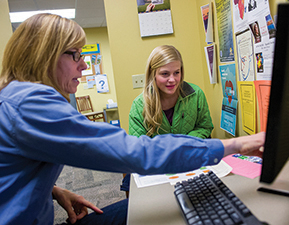
MSU’s Academic Advising center helps students create an academic plan.
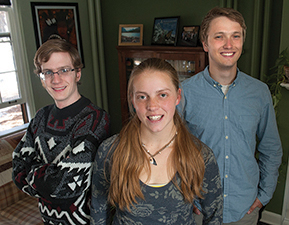
MSU’s Goldwater Scholarship recipients Connor Murnion, Katherine Kent and McLain Leonard.
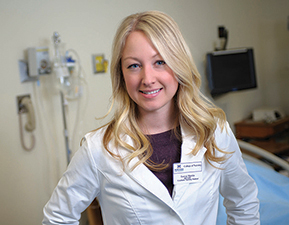
Terryn Martin is enrolled in the College of Nursing’s new doctor of nursing practice program.

MSU English professor Marvin Lansverk received a national award from the American Society for Eighteenth-Century Studies.
Discovery Return to Top Progress Report 2014
Innovative and significant research and creative activities are a recognized hallmark of MSU, where faculty, students and staff all participate in the creation of knowledge and art.
Goal:MSU will raise its national and international prominence in research, creativity, innovation and scholarly achievement, and thereby fortify the university’s standing as one of the nation’s leading public research universities.
Objective D.1:Elevate the research excellence and recognition of MSU faculty.
Objective D.2:Enhance infrastructure in support of research, discovery and
creative activities.
Objective D.3:Expand the scale, breadth and quality of doctoral education.
Strategies
- Improve support for faculty active in research and creativity through enhanced professional development, additional financial support and facilities improvements
- Increase the number of grant-active faculty through strengthened grant-writing support, expanded collaboration across disciplines and opportunity hires
- Create affiliate appointments for faculty from other institutions
- Expand interdisciplinary efforts in research, creative activity and graduate education
- Increase capacity and strengthen recruiting for high quality graduate programs by improving the number and amount of graduate stipends, encouraging more faculty to advise doctoral students and establishing timely pathways to degree completion
Budget alignment (2013–14 investments unless otherwise noted)
- $675,000 in additional salary and research support to retain MSU’s talented faculty
- $10 million in new faculty startup packages
- $200,000 awarded in 2014 to competitive research expansion fund proposals to jumpstart new research programs with high probability of additional external funding
- $550,000 for market, merit, equity and promotion increases for tenured and tenure- track faculty
- $600,000 for competitively awarded graduate assistantships, meritorious fellowships, enhanced graduate recruitment and retention
- $240,000 for Native American graduate students in science and engineering committed over the next three years to match MSU’s successful Sloan Foundation grant
- $45,000 to implement advising and curricular software for graduate students in support of timely progress toward degree
Successes
- Improving Graduate Education for American Indians—MSU is part of a new national network, the Sloan Indigenous Graduate Partnership, designed to strengthen and expand successful initiatives to recruit, train and graduate American Indian and Alaska Native students in STEM disciplines. The network is funded through a $2.4 million grant from the Alfred P. Sloan Foundation. (Also supports Access)
- Meeting Grand Challenges—Faculty members at MSU have twice been awarded Grand Challenges Explorations Grants, an initiative funded by the Bill & Melinda Gates Foundation to carry out bold ideas for overcoming challenges to global health. Dave Sands, a professor in the Department of Plant Sciences and Plant Pathology, won a grant to enable people in 50 Kenyan villages to defend against a parasitic weed that kills 30 to 80 percent of their corn, millet and sorghum crops. Sands discovered a fungus that kills the weed without harming the environment. Seth Walk, assistant professor in the Department of Microbiology and Immunology, and his collaborators will develop a 3-D human tissue culture to study gastrointestinal tract dysbiosis more effectively than using mouse models.
- Noteworthy Discoveries—A major Antarctic expedition that involved MSU researcher John Priscu and other MSU faculty, students and staff was one of Discover magazine’s top 100 science stories of 2013, and an article on Yellowstone National Park microorganisms was one of the 10 most popular last year in the journal, Frontiers in Microbiology. The lead author was William Inskeep, Land Resources and Environmental Science professor.
- Major Grant Initiatives—MSU averages $100 million in research annually.
- MSU is leading a multi-institutional collaboration of scientists who have won a $10 million, four-year federal research grant to hunt for breakthroughs in producing more energy from biofuels. The project, led by John Peters, professor of chemistry and biochemistry and the lead principal investigator, has the potential for game-changing advances in biofuel production.
- MSU is part of a four-state consortium that was awarded nearly $10 million to investigate the challenges of turning beetle-killed trees into biofuel by the U.S. Department of Agriculture. An interdisciplinary and multi-institutional project involving scientists, landowners and government officials, the grant will enable the consortium to study the major challenges that limit the use of beetle-killed trees in the Rockies as biofuel.
- The National Science Foundation awarded a five-year, $2 million grant for a collaborative study led by MSU plant sciences professor Mark Young to explore the role of viruses in shaping ecosystems in the hot springs of Yellowstone National Park.
- Expanding Curricular Boundaries—MSU will offer a master’s degree and a minor in optics and photonics, emphasizing one of the university’s strengths. The programs will build on Bozeman’s growing reputation as a center of creativity and commercialization in the field of laser and imaging optics.
- Lifetime Achievement—MSU paleontologist Jack Horner has won the highest honor given by the Society of Vertebrate Paleontology. The Romer-Simpson Medal which is bestowed upon an individual for “sustained and outstanding scholarly excellence and service to the discipline of vertebrate paleontology.”
- Regents Professor Named to National Academy of Inventors—Regents Professor Anne Camper was named a 2013 Fellow of the National Academy of Inventors. Camper, whose patents relate to water and food safety and the detection of potential bioterrorism agents, was one of just 143 innovators selected in 2013.
- Breakthrough Ag tech headed to EPA for approval—Certis USA, a top manufacturer of biological pesticides, announced that a disease-fighting bacterium discovered at MSU by plant sciences professor Barry Jacobsen is now heading for regulatory review in the U.S. and Canada, a final hurdle to bringing the technology to market. (Also supports Engagement)
- Emmy wins for MSU grads and Montana PBS— Montana PBS and Montana State University alumni won four Emmys at the 51st Annual Northwest Regional Emmy Awards this month in Seattle with "11th and Grant with Eric Funk" and "Indian Relay" both winning in two categories.
- MSU graduate and entomologist wins Presidential Early Career Award— Justin Runyon, an MSU graduate and entomologist on the MSU campus, was one of 102 researchers chosen to receive the latest Presidential Early Career Award for Scientists and Engineers (PECASE) and one of only three recipients nominated through the U.S. Department of Agriculture. The award recognizes his "outstanding and sustained accomplishments that significantly increased knowledge in biocontrol of invasive species, chemical ecology of plants, and insect diversity and taxonomy."
- MSU professor and team publish brain research in Nature—An MSU assistant professor in neuroscience is part of a team that has made progress understanding how the brain processes visual information. In addition to adding to the basic understanding of brain function, the research may also have implications for understanding schizophrenia and attention deficit disorders. MSU's Behrad Noudoost was a co-author with Marc Zirnsak and other neuroscientists from the Tirin Moore Lab at Stanford University in publishing a recent paper on the research in Nature, an international weekly journal for natural sciences.
- MSU team prove microbes swim to hydrogen gas—Microbiology professor Matthew Fields recently published a paper in the journal of "Scientific Reports" about a scientific breakthrough that helps fill in gaps of knowledge about microorganisms that are crucial to Earth's carbon cycle, early Earth processes and climate change. Fields proved a long held scientific belief that microorganisms that produce methane swim toward the hydrogen gas they need to stay alive.
- National rural health conference held at MSU—Experts in health and nursing from around the world gathered at Montana State University as part of the 2014 International Rural Health and Rural Nursing Research Conference, bringing visibility to MSU's medical and rural health programs.
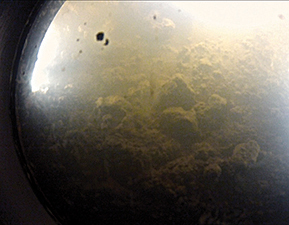
The first view of the bottom of subglacial Lake Whillans, from a major Antarctic expedition involving MSU researcher John Priscu.
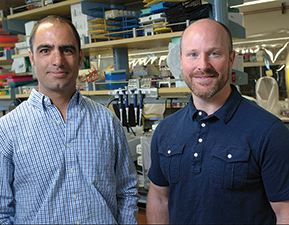
Blake Wiedenheft, left, and Seth Walk are part of a team studying how disease-causing microbes interact with the human gastrointestinal tract.
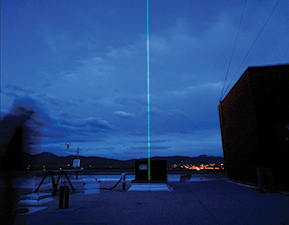
New master’s and minor in optics and photonics.
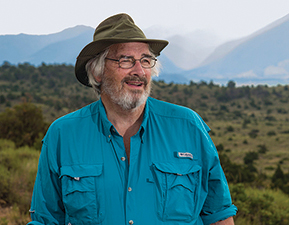
Regent’s Professor Jack Horner, recognized by the Society of Vertebrate Paleontology.
Engagement Return to Top Progress Report 2014
Engagement is the collaboration between MSU and its local, state, national and global communities for the mutually beneficial exchange of knowledge and resources in a context of partnership and reciprocity (Carnegie Foundation, 2006). Engagement, a form of scholarship that bridges teaching, research and service, brings the university’s intellectual resources to bear on societal needs (Association of Public and Land-grant Universities’ Council on Engagement and Outreach).
Goal: Members of the Montana State University community will be leaders, scholars and engaged citizens of their local, national and global communities, working together with community partners to exchange and apply knowledge and resources to improve the human prospect.
Objective E.1:Strategically increase service, outreach and engagement at MSU.
Objective E.2:MSU graduates will have global and multicultural understanding
and experiences.
Objective E.3:MSU students, faculty and staff will have increased opportunities for leadership development.
Strategies
- Build support structure to connect MSU students, staff and faculty with engagement information and opportunities
- Emphasize engagement and outreach in faculty hiring and development; provide training and professional development opportunities for service learning and engagement
- Build on the success of and partner with Extension, Museum of the Rockies and other externally-facing MSU programs
- Expand the involvement with the private sector following the models of programs through OpTeC or the Industrial Associates Program for the Center for Biofilm Engineering for other disciplines
- Strengthen support for leadership and cultural development experiences
Budget alignment (2013–14 investments unless otherwise noted)
- $160,000 in student and matching support for student organizations, nearly double the prior year
- $70,000 to support the Year of Engaged Leadership series of programs, lectures and events
- $30,000 to support work of the Outreach and Engagement Council
- $12,000 in base funding for Leadership MSU
Successes
- Centennial Celebration—MSU Extension celebrated its centennial anniversary in 2014 with special events around the state and continued local education programs. MSU Extension is a network of educators in all counties of the state and specialists on the MSU campus providing unbiased, research-based education programs and information to strengthen the social, economic and environmental well-being of Montana citizens.
- Serving Communities and Community Leaders
- The Wibaux Endowment Foundation allows residents of the eastern Montana county to contribute to a fund supporting everything from youth sports teams to ambulance services to a school reunion. Wibaux County’s MSU Extension agent, Dave Bertelsen, serves on the foundation’s board and works with community members to organize meetings, set fund-raising goals and liaise with the Montana Community Fund.
- The MSU Extension Local Government Center provides the only training, technical assistance and research of its kind for Montana’s county and city elected officials and employees. The LGC offers more than 100 professional development workshops each year that educate more than 6,000 local officials and citizen board members.
- Student-Community Connections
- Building on a successful partnership between MSU students and the Carter County Museum, the Student Community Outreach ProjEct (SCOPE) beautifully illustrates Montana State’s land-grant mission. SCOPE student organizers match students and communities on projects that combine outreach and student research. (Also supports Integration)
- MSU’s Jake Jabs College of Business and Entrepreneurship partners with local and regional businesses and non-profits willing to offer students practical business experience in return for research, issue analysis or operational advice.
- The Office of Activities and Engagement was recognized for involving a record number of students in the Compact Service Corps AmeriCorps program[BROKEN LINK]. MSU students volunteered and served a collective total of 171,000 hours across the state on Montana, the vast majority providing primary and preventive health care services.
- Bioscience Outreach—Teen-aged 4-H members from throughout Montana swabbed volleyballs for bacteria, tracked their dietary intake of Omega-3s versus Omega-6s, and evaluated the healthiness of pet food, all part of a year-long university experience called Bioscience Montana. The project connects teens to scientific research, bioscience-related careers and distance learning technologies. It is funded by the National Institutes of Health as a Science Education Partnership Award given to MSU. (Also supports Access)
- Cultural Attunement—Education professor Jioanna Carjuzaa received the G. Pritchy Smith Multicultural Educator of the Year Award for her scholarly commitment to teaching from a multicultural perspective, addressing multiple facets of diversity, and setting an example of multicultural ideals and practices. Carjuzza’s work in and out of the classroom introduces hundreds of MSU students to multicultural scholarship each year.
- Living Leadership—MSU will offer a new residence hall living option for incoming freshmen interested in developing leadership skills beginning in fall 2014. The Emerging Leaders Living Learning Community, a co-ed living option, focuses on engaging first-year students interested in leadership.
- Can the Griz food drive success—Montana State University and the Bozeman community rallied for a big win in the 14th annual Can the Griz Food Drive, with supporters donating more than 100,000 pounds of food and more than $47,000 to the Gallatin Valley Food Bank. MSU and the Bozeman community's total this year was 100,939 pounds of food and $47,445.38 donated to the Gallatin Valley Food Bank
- Cattlewomen win food bank challenge—The MSU Collegiate CattleWomen's Club won a national competition, and the prize - 30,500 pounds of chicken products from Tyson Foods, Inc. - was donated to the Gallatin Valley Food Bank. The group won the contest by collecting 500 pounds of canned goods during the annual "Can the Griz" food drive last fall and completing other weekly assignments in the annual Animal Agricultural Alliance Online College Aggies Scholarship Competition.
- Fermenting research project pairs MSU researchers with local businesses—Wildrye is partnering with 406 Brewing Co. and Dean's Zesty Beverages, a kombucha maker, to create the Montana Fermentation Research Center. The center combines science with Montana-made products in hopes of benefiting food and beverage producers in the state. To help speed up development, they are working with MSU professor Brian Bothner and graduate student Tim Hamerly to develop and license tools that would scientifically classify whiskey and other products. The tools would simplify the process of defining flavors of wines, beers and spirits. (Also supports Integration)
- Good neighbor bags—Montana State University partners twice a year with the City of Bozeman on Saturday to deliver "Good Neighbor Bags" to homes in neighborhoods close to MSU. The campaign drops on doorsteps bags containing a few helpful ideas about what makes a good neighbor.
- Old breeds get new life as turf grass—"'Give me a grass I don't have to mow!'" people demand, said Tracy Dougher, horticulture professor at Montana State University. MSU researchers have been looking for some time for a grass that needs less watering and less mowing. Americans spend billions and considerable energy on their lawns. Dougher is experimenting with a different idea - native grasses. This summer she's growing a plot with 11 varieties of fine fescue grass, mown at different heights, to see how well they perform. (Also supports Stewardship)
- MSU based program wins grant for nutrition education—An MSU-based program that provides nutrition education and training in schools won nearly $300,000 from the U.S. Department of Agriculture to continue to build resources and provide support for nutrition education, school wellness policy programs and Farm to School programs in K-12 classrooms across the state.
- Contemporary American Indian Art—MSU's Department of Native American Studies opened a Gallery of Contemporary American Indian Art in 2014, with an inaugural exhibit by Blackfeet artist Louis Still Smoking. (Also supports Access)
- Open access library project—The Montana State University Library has taken a big step toward making important physics research more widely accessible. A new system in which the MSU library is participating is more inclusive and promotes open, easy access to information, said Leila Sterman, MSU scholarly communication librarian. (Also supports Integration and Discovery)
- Teens in MSU outreach project win state science fair prize—Two brothers from Columbia Falls have won Montana's top science fair prize with a research project they developed through a Montana State University outreach project called BioScience Montana.
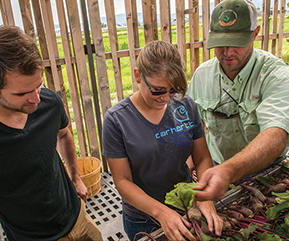
Townes Harvest Garden recognized as a top 10 program by the Association of Public and Land-grant Universities.
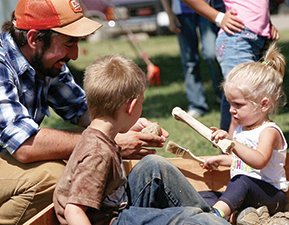
Student Community Outreach ProjEct (SCOPE).

Professor Jioanna Carjuzaa received the G. Pritchy Smith Multicultural Educator of the Year Award.

Members of MSU’s Leadership Institute met with Maya Angelou. Photo courtesy of MSU Leadership Institute.
Integration Return to Top Progress Report 2014
Integrating learning, discovery, and engagement is the marquee feature of this MSU strategic plan. Traditionally, land-grant universities have educated students, conducted research and provided outreach to their communities and states. MSU has gone a step further by regularly integrating research and teaching, practicing service-learning and combining research with outreach. With this plan, MSU now boldly defines the 21st century land-grant university as one where learning, discovery and engagement merge seamlessly to the benefit of students, faculty, staff and the wider community.
Goal: By integrating learning, discovery and engagement, and by working across disciplines, the MSU community will improve the world.
Objective I.1: Increase the integration of learning, discovery and engagement.
Objective I.2:Increase work across disciplines.
Strategies
- Align workload, promotion and tenure processes with strategic goals, including integration activities
- Strengthen support for student involvement in discovery and engagement through new and existing programs
- Coordinate and foster community-based research projects, including Community Based Participatory Research, to advance efforts through integration, sharing of lessons, pooling of resources and joint proposals
- Highlight and build upon successes in interdisciplinary curriculum and research through interdisciplinary faculty hires, highlighted areas of research strengths and new interdisciplinary academic programs
Budget alignment (2013–14 investments unless otherwise noted)
- $300,000 to support new faculty lines beginning in 2013 and 2014 addressing interdisciplinary field of Rural Health
- $100,000 to support new faculty line beginning Fall 2014 in new interdisciplinary, multi-campus Materials Science program
- $250,000 institutional commitment and grant support for the Blackstone Launchpad in support of student entrepreneurship and translational student research
Successes
- Exemplary Integration—MSU’s Towne’s Harvest Garden earned national recognition from the Association of Public and Land-Grant Universities, APLU, as one of only ten exemplary outreach programs in the nation. Students’ work with the garden spans learning, discovery, and engagement: THG supports the Sustainable Foods and Bioenergy Systems degree program, students apply new knowledge gleaned from diverse disciplines like horticulture, nutrition, and marketing, and the harvest is shared with the community through community-supported-agriculture shares, farmers markets, and the Gallatin Valley Food Bank.
- Writing for Change—Students in Jill Davis’s Writing 101 course were partnered with an elderly Bozeman citizen for eight weeks in a “Tuesdays With Morrie” service learning experience. The project integrates quality coursework and outreach to the community for a win-win-win outcome. The participating seniors find it helpful to reflect on their lives with an attentive, thoughtful listener, said Davis. Students find it beneficial to slow down and share their busy lives with an elder who cares and offers sage counsel. The descriptive narratives produced by students are seen as valuable documents for the interviewee’s family.
- Putting Expertise to Work for Pulse Crops—Work is beginning this summer to establish a regional laboratory at Montana State University for diagnosing insects, diseases and weeds in pulse crops. Growers of chickpeas, dry peas and lentils will be able to send samples to the lab as soon as this fall. (Also supports Engagement)
- From Classroom to Space—Two student-built satellites, collectively known as FIREBIRD, launched on NASA missions through NASA’s Educational Launch of Nanosatellites program. Approximately 30 students were involved in the construction of the satellites providing them meaningful, hands-on opportunities to work on high level projects as undergraduates.
- Integrating graduate education and outreach—Laura Brutscher, a doctoral student in microbiology and a Molecular Biosciences Program Fellow, helped young Montanans become "honey bee investigators" during a summer camp at Montana State University. The MSU graduate student has now received a major fellowship to expand her own honey bee investigations. (Also supports Engagement and Discovery)
- Translational Transportation Research—The federal government has once again chosen the Western Transportation Institute at MSU as a lead institution for its prestigious University Transportation Center program. MSU is the only university in the Rocky Mountain region selected to lead one of these centers, which are funded by the U.S. Department of Transportation to foster research, education and outreach activities.
- Faculty Excellence Awarded—The MSU Center for Faculty Excellence was recognized as a 2014 Exemplary Teaching and Learning Center at the 25th International Conference on Teaching and Learning, one of just 12 honored. MSU’s Center for Excellence provides professional enhancement of faculty in the areas of teaching, research, creative activities and engagement. (Also supports Learning, Discovery and Engagement)
- Interdisciplinary and Multi-University—Seventeen undergraduates from the Montana University System and one student from Salish Kootenai College received summer internships from the Montana Institute on Ecosystems to research environmental and climate change-related projects throughout Montana. Students will work with IoE faculty on a variety of projects, including invasive cheatgrass, Douglas fir, the influence of wildfire and fire history, honeybees, cicadas and westslope cutthroat trout.
- Honors College elevated—MSU's Honors Program was elevated to college status this year. In addition to a degree in their departmental majors, honors students who complete curriculum requirements also graduate with a University Honors degree. Honors students have brought great distinction to MSU and the state by serving as ambassadors, tutors, organization leaders, agents of outreach and service and by gaining admittance to some of the nation's top graduate schools.
- IT upgrades enhance campus work—From improved core capacity to a newly unified log-in system to improved and expanded wireless networks across campus, the series of improvements launched by MSU's Information Technology Center addresses the demands of record enrollment, data-intensive research and the rapid proliferation of personal wireless devices, as well as Internet traffic to websites rich in multimedia and complex graphics.
- Student Research Celebration—MSU's annual Student Research Celebration, organized by the Undergraduate Scholars Program, enabled more than 250 students representing all disciplines to publicly showcase their scholarly work through a poster presentation. A sampling of projects include: examination of dinosaur eggs from China; analysis of markets for emerging wines; discovery of a new virus in Yellowstone National Park; and a study of depression in migrants.
- Undergrad research is published in international journal—A Montana State University student's research into a technique that will help forensic anthropologists speed up their analysis processes is the subject of a paper published recently in an international journal as well as a presentation at Harvard Medical School. A paper written by Michael Ruiz, 26, a senior majoring in anthropology, on a technique he developed for defleshing bones by increasing the proportion of undiluted bleach, was published in the International Journal of Arts and Sciences. Ruiz also presented his research in May at conference held at Harvard Medical School. (Also supports Discovery)
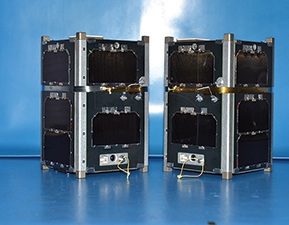
Two MSU student-built CubeSats launched from the Vandenberg Air Force Base. Photo courtesy of MSU’s Space Science and Engineering Laboratory
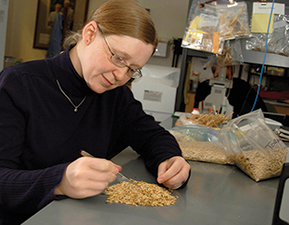
Mary Burrows, director of a new project that will establish a Pulse Crop Health Diagnostic Laboratory at MSU.

MSU grad student Laura Brutscher received a fellowship to investigate honey bees and the pathogens that infect them.

The Western Transportation Institute’s driving simulator.
Access Return to Top Progress Report 2014
Land-grant universities were established by Congress in 1862 with the explicit intent to educate the sons and daughters of the industrial classes. MSU continues to fulfill that intent, believing that education serves society as a whole through job creation, stronger civic participation and a reduction in the societal costs borne by a less educated populace. MSU does not turn away qualified Montanans and will continue to provide access to a quality education for all students to improve the state and the wellbeing of its citizens.
Goal: Montana State University is committed to widening access to higher education and ensuring equality of opportunity for all.
Objective A.1:Educate more students while maintaining the quality of programs.
Objective A.2:Diversify the student body.
Strategies
- Enhance financial aid offerings and limit cost increases so that MSU remains affordable
- Address growing student debt issues through financial literacy programs, advising, appropriate course loads and career coaching
- Expand course and program offerings, delivery times, and instructional methods to meet the needs of a more diverse student audience, including the expansion of online course offerings
- Actively recruit from diverse student pools and support students with specific needs once enrolled at MSU, such as non-traditional aged students, veterans and American Indian students
Budget alignment (2013–14 investments unless otherwise noted)
- $1.1 million in institutional scholarships for Montana students
- $750,000 in institutional support of veteran students through the Yellow Ribbon program
- $100,000 in new Native American student recruitment, retention, and success strategies to supplement ongoing initiatives
- $300,000 from MSU’s success in the statewide performance funding model specifically pledged for additional frequency and capacity in high-demand required courses
- $200,000 for summer session to enhance year-round access
- $70,000 invested in Core at Night to serve working populations
- $160,000 institutional and grant-funded investment in financial literacy programs to minimize student debt
Successes
- Best for Vets—Montana State University has earned a spot on the inaugural list of best colleges for veterans published by U.S. News & World Report. MSU was one of 234 universities and colleges to earn a spot on the list. The magazine developed the new rankings to help veterans pursue a college education under the Post-9/11 GI Bill. “Montana State University has been diligently working for years to provide support to our student-veterans and help them succeed,” said Brenda York, director of MSU Disability, Re-entry and Veteran Services. “We’re very proud of this important work, and we are pleased that our efforts have been recognized by U.S.News & World Report.”
- Expanding the calendar and the classroom—MSU began Core at Night, a variety of CORE 2.0 courses on the Bozeman campus in the evenings to provide greater access to non-traditional students and those who work during the day. Many new online courses aimed at working professional were offered for the first time, including Spanish for business and healthcare professionals, climate science for teachers and biodiversity for professionals.
- Caring for Our Own—The MSU College of Nursing won a three-year grant totaling more than $1 million that will enable it to continue providing support to American Indian and Alaska Native students through the Caring for Our Own Program, or CO-OP.
- Bringing MSU to the high school—Taught by MSU professor John Paxton, “The Joy and Beauty of Computing” offers 25 high school students an overview of the world of computing, as well as a gentle introduction to computational thinking using the Python programming language. It also offers dual credit at the high school and MSU.
- Serving more students—MSU enrolled 15,294 students in fall 2014, an enrollment record for the university. It is the seventh time in the last eight years that MSU has set an enrollment record. In the four years since 2009, MSU has seen a 19.8 percent jump in enrollment.
- Contemporary American Indian Art—MSU's Department of Native American Studies opened a Gallery of Contemporary American Indian Art in 2014, with an inaugural exhibit by Blackfeet artist Louis Still Smoking.
- Asbjornson gift—Norm Asbjornson, a Montana State University alumnus and Montana native from the small town of Winifred, has committed to give the university $50 million for its College of Engineering - the largest private gift in the history of the state. Asbjornson's gift will fund the construction of an innovative laboratory and classroom facility that will enable the collaborative, hands-on learning and leadership that embody the university's legacy and mission. The building, to be named the Norm Asbjornson Innovation Center, is envisioned to promote dynamic interdisciplinary engagement, meaningful student-faculty interaction, and accelerated innovation that responds to and anticipates emerging trends in education, industry and society. (Also supports Integration)

MSU has earned a spot on the inaugural list of best colleges for veterans published by U.S. News & World Report.
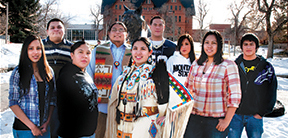
Students from the American Indian Council gather in Alumni Plaza.
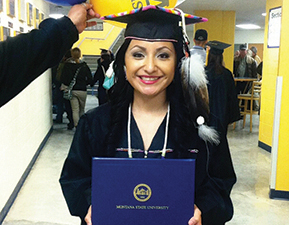
Caring for Our Own program.
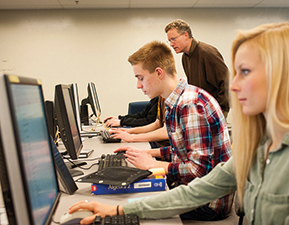
A dual-credit course cotaught by John Paxton, is part of an effort to boost the number of Montana students on the computer science career track.
Stewardship Return to Top Progress Report 2014
As a public institution, MSU recognizes and honors its obligation to the many constituents who invest their time, financial resources, energy and support. MSU deeply values the public trust granted to it and is committed to continued good stewardship of its resources.
Goal: As steward of a land-grant institution, MSU will responsibly manage its human, physical, economic and environmental resources in an open and sustainable manner.
Objective S.1:Human Resources. Attract, develop and retain the best faculty and staff to achieve the MSU mission.
Objective S.2:Physical Resources. Enhance aesthetic appeal and functional quality of MSU physical resources to support
high quality learning, research and work environments.
Objective S.3:Economic Resources. Increase and effectively allocate resources in support of the MSU Strategic Plan.
Objective S.4:Environmental Resources. Promote sustainable stewardship and a culture of resource conservation at MSU.
Strategies
- Develop our human resources through improved compensation and professional development opportunities
- Improve administrative processes to make MSU more effective and enhance the work environment
- Invest in functional and aesthetic improvements to our physical infrastructure
- Invest in energy saving building upgrades
Budget alignment (2013–14 investments unless otherwise noted)
- $600,000 for market, merit, equity and promotion increases for tenured and tenure- track faculty
- $675,000 in additional salary and research support committed to retain high achieving faculty
- $175,000 to support professional development and training for faculty and staff
- $700,000 additional funding committed to information technology improvements
- $150,000 in software and process changes to streamline hiring and other administrative processes
- $2.7 million investment in technological, functional and aesthetic upgrades to instructional spaces
- $24 million investment since 2010 in efficiency program to reduce energy, water and operations waste
Successes
- HR Redefined—MSU’s Human Resources function underwent significant change in the last two years with renewed emphasis on recruiting and developing our human resources while lightening the paperwork and process load. As a result, President Waded Cruzado received the College and University Professional Association for Human Resources (CUPA-HR) 2014 Chief Executive HR Champion Award. Recognizing that what makes an institution great are its people, this award honors a president or chancellor of a higher education institution or system who has demonstrated significant support for the institution’s human resources function.
- Preparation—Partially funded by a grant from the Montana Disaster Emergency Services Department, MSU now has an Office of Emergency Management, a newly published Emergency Operations Plan, and a comprehensive Emergency Management website. The Office of Emergency Management hosted two table top emergency exercises in 2014 to maximize coordination across the community in the event of an emergency.
- Unprecedented Gift for Innovation—Norm Asbjornson, an MSU alumnus and Montana native from the small town of Winifred, committed $50 million for the College of Engineering—the largest private gift in the history of the state. Asbjornson’s gift will fund construction of an innovative laboratory and classroom facility that will enable the collaborative, hands-on learning and leadership that embody the university’s legacy and mission. The building, to be named the Norm Asbjornson Innovation Center, is envisioned to promote dynamic interdisciplinary engagement, meaningful student-faculty interaction, and accelerated innovation that responds to and anticipates emerging trends in education, industry and society, and will be designed and built with a Net Zero Energy approach.
- Enhanced IT—From improved core capacity to a newly unified log-in system to improved and expanded wireless networks across campus, the series of improvements launched in 2013-14 by MSU’s Information Technology Center addressed the demands of record enrollment, data-intensive research and the rapid proliferation of personal wireless devices, as well as Internet traffic to websites rich in multimedia and complex graphics.
- Aesthetic appeal and functional quality—The Computer Science student lab has been transformed from a traditional study space to something more like a Bay Area tech start-up, with adjustable lighting, carpeted floors, lounge seating and Japanese theme. Using funding from the Strategic Investment Proposal process, CS has created a professional workplace tone while attracting more students to study and work in the space, even creating competition among student employees for shifts.
- Residence Hall Retrofits—Iconic North Hedges Hall has seen building efficiency increase 21 percent since 2009. Additional retrofitting of the ventilation system in 2014 will make that a 60 percent increase. The North Hedges project is just one of the efforts to increase energy efficiency across campus, saving money and precious resources.
- Fieldhouse and SUB renovations—Montana State University won approval from the state Board of Regents to spend more than $6 million renovating the Brick Breeden Fieldhouse and Strand Union Building ballrooms with functional and performance ungrades designed to serve not just MSU students, faculty, and staff, but the whole community. These well-used public venues will see major improvements in the coming year.
- Montana Made program director hired—Montana State University now has a full-time person working to bring more Montana food and products to campus. Nicole Morgan is the new Montana-Made program manager, building on efforts that began 10 years ago and were coordinated entirely by students working part-time.
- MSU's new Jabs Hall receives passive solar wall—A passive solar wall installed atop Montana State University's new Jabs Hall could pay for itself in 10 years, reduce the amount of energy used to heat the building and provide valuable data to research engineers. Installation of the solar wall is one of many sustainable technologies being used to reduce the building's energy use and carbon footprint. Kevin Amende, assistant professor of mechanical engineering technology, said the data his lab collects will be an asset to engineers and architects on future projects. The research project, which is being launched by mechanical engineering technology junior Ben Listowich of Kingfield, Maine, will combine data collected from a weather station atop Jabs Hall with data collected from sensors at various points within the solar wall. By also tracking the building's HVAC system, Amende said the study should offer a pretty good picture of how the technology is performing within three or four years. (Also supports Integration)
- Tree Campus USA, again—For the second year in a row the Arbor Day Foundation has named MSU a 2013 Tree Campus USA in honor of its commitment to effective campus forest management and for engaging staff and students in conservation goals.

The Computer Science Department’s new student success center.

MSU alumnus Norm Asbjornson committed to give the university $50 million for its College of Engineering—the largest private gift in the history of the state.

An ongoing series of infrastructure improvements and upgrades has MSU’s computer network poised to be one of the largest and most dynamic in the state.
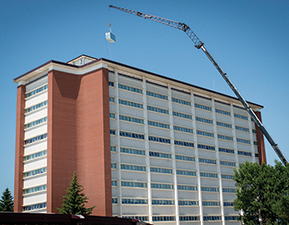
New high-efficiency heat recovery ventilation unit fitted to North Hedges, as part of an effort to make the building more energy efficient.
Selected Plan Metrics Return to Top Progress Report 2014
|
Learning |
2009-10 |
2010-11 |
2011-12 |
2012-13 |
2013-14 |
||
|
Objective L.2: Increase graduation rates at MSU. |
|||||||
|
L.2.1 |
Bachelor Graduation Rate (entering cohort from 6 years prior) |
48% |
47% |
51% |
49% |
50% |
|
|
L.2.3 |
Associate Degrees Awarded (Summer, Fall, Spring)* |
- |
9 |
31 |
28 |
40 |
|
|
L.2.3 |
Workforce Certificates Awarded (Summer, Fall, Spring)* |
- |
13 |
20 |
47 |
46 |
|
|
L.2.4 |
FTFTF Retention Rate (entering cohort from prior Fall) |
72% |
74% |
74% |
74% |
76% |
|
|
Objective L.3: Increase job placement and further education rates. |
|||||||
|
L.3.1 |
Employed in Major Field or Position of Choice (one year post-grad) |
57% |
66% |
63% |
64% |
66% |
|
|
L.3.2 |
Graduate School Enrollment (one year post-grad) |
20% |
25% |
22% |
18% |
23% |
|
|
Discovery |
2009-10 |
2010-11 |
2011-12 |
2012-13 |
2013-14 |
||
|
Objective D.3: Expand the scale, breadth and quality of doctoral education. |
|||||||
|
D.3.2 |
Graduate student headcount |
1,924 |
1,980 |
1,965 |
1,888 |
2,030 |
|
|
D.3.2 |
Doctoral student headcount |
401 |
396 |
397 |
420 |
481 |
|
|
D.3.3 |
Graduate Degrees Awarded (Summer, Fall, Spring) |
519 |
548 |
591 |
557 |
562 |
|
|
D.3.3 |
Doctoral Degrees Awarded (Summer, Fall, Spring) |
45 |
56 |
53 |
49 |
56 |
|
|
Access |
2009-10 |
2010-11 |
2011-12 |
2012-13 |
2013-14 |
||
|
Objective A.1: Educate more students while maintaining the quality of programs. |
|||||||
|
A.1.1 |
Montana Undergrad Headcount Enrollment (Fall) |
7,893 |
8,240 |
8,586 |
8,680 |
8,828 |
|
|
A.1.2 |
New Transfer Students (Summer and Fall) |
801 |
913 |
973 |
988 |
933 |
|
|
A.1.3 |
Graduate Student Headcount Enrollment (Fall) |
1,924 |
1,980 |
1,965 |
1,888 |
2,030 |
|
|
A.1.4 |
Online Credits (AY) |
12,283 |
15,536 |
14,755 |
16,212 |
27,465 |
|
|
A.1.4 |
Online Courses (AY) |
124 |
166 |
162 |
213 |
280 |
|
|
A.1.5 |
Gallatin College Headcount Enrollment (Fall)* |
- |
100 |
199 |
228 |
324 |
|
|
A.1.6 |
Percent Financial Need Met (prior AY) |
72% |
74% |
74% |
72% |
72% |
|
|
A.1.7 |
Total Headcount Enrollment (Fall) |
12,764 |
13,559 |
14,153 |
14,660 |
15,294 |
|
|
Objective A.2: Diversify the student body. |
|||||||
|
A.2.1 |
Native American Student Headcount Enrollment (Fall)† |
- |
500 |
545 |
580 |
573 |
|
|
A.2.2 |
Other Under-Represented Ethnicity and Race Headcount Enrollment (Fall)† |
- |
904 |
947 |
1,065 |
1,206 |
|
|
A.2.3 |
International Student Headcount Enrollment (Fall) |
460 |
516 |
553 |
599 |
606 |
|
|
A.2.4 |
Nontraditional Age Student Headcount Enrollment (Fall) |
2,247 |
2,447 |
2,655 |
2,781 |
2,693 |
|
|
Stewardship |
2009-10 |
2010-11 |
2011-12 |
2012-13 |
2013-14 |
||
|
Objective S.2: Physical Resources. Enhance aesthetic appeal and functional quality of MSU physical resources to support high quality learning, research and work environments. |
|||||||
|
S.2.1 |
Percent of classrooms with technology rated tier 3 or above (Recorded periodically)†† |
- |
- |
2% |
6%
|
7% |
|
|
S.2.1 |
Percent of classrooms with technology rated tier 2 (Recorded periodically)†† |
- |
- |
58% |
62% |
62% |
|
|
Objective S.4: Environmental Resources. Promote sustainable stewardship and a culture of resource conservation at MSU. |
|||||||
|
S.4.1 |
Greenhouse Gas Emissions (Metric Ton CO2 equivalent) |
68,159
|
66,566 |
64,412 |
64,909 |
60,913 |
|
|
S.4.2 |
Diverted waste from landfill |
6.0%
|
7.2% |
9.5% |
9.2% |
11.8% |
|
* Gallatin College began awarding degrees and certificates in 2010-11
†Federal race and ethnicity categories changed in 2010, making historic comparisons impossible
††Expanded list of included instructional spaces in 2012-13
MSU by the Numbers Return to Top Progress Report 2014
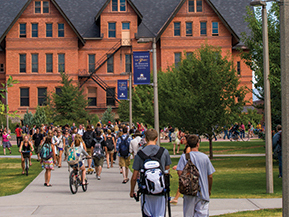
Student enrollment continues to grow.
Enrollment
|
Fall 2013 Undergraduate Headcount Enrollment |
13,264 |
|
Fall 2013 Graduate Headcount Enrollment |
2,030 |
Faculty
|
Fall 2013 Full-time Faculty |
549 |
|
Fall 2013 Part-time Faculty |
375 |
|
Student to Faculty Ratio |
19:1 |
Degrees
|
2013-14 Certificates and Associate Degrees Awarded |
86 |
|
2013-14 Bachelors Degrees Awarded |
2,132 |
|
2013-14 Master Degrees Awarded |
506 |
|
2013-14 Doctoral Degrees Awarded |
56 |
Fall 2013 Enrollment by College
|
Undergrad |
Graduate |
Total |
|
|
Agriculture |
880 |
148 |
1,028 |
|
Arts & Architecture |
1,151 |
113 |
1,264 |
|
Business |
1,195 |
38 |
1,233 |
|
Education & HHD |
1,512 |
456 |
1,968 |
|
Engineering |
2,910 |
192 |
3,102 |
|
Graduate School |
0 |
312 |
312 |
|
Letters & Science |
3,152 |
477 |
3,629 |
|
Nursing |
902 |
82 |
984 |
|
Gallatin College |
324 |
0 |
324 |
|
University College |
1,238 |
0 |
1,238 |
|
Other |
0 |
212 |
212 |
|
Total |
13,264 |
2,030 |
15,294 |
Fall 2013 Enrollment by Gender
|
Female |
7,077 |
|
Male |
8,217 |
Fall 2013 Enrollment by Race and Ethnicity (individuals may be counted more than once if self-identified with more than one race or ethnicity)
|
American Indian/Alaska Native |
573 |
|
Asian |
584 |
|
Black/African American |
200 |
|
Hispanic |
509 |
|
Native Hawaiian/Pacific Islander |
71 |
|
White |
13,978 |
|
International |
606 |
|
Unknown/Other |
162 |
Fall 2013 Undergraduate Enrollment by Age
|
Under 24 years old |
10,571 |
|
24 years old and older |
2,693 |
First-Time Full-Time Freshmen
|
High School GPA |
3.41 |
|
ACT Comprehensive Score |
25.2 |
|
SAT Score |
1711 |
Employees
|
Fall 2013 Full-time Employees, including Faculty |
2,251 |
|
Fall 2013 Part-time Employees, including Faculty |
742 |
